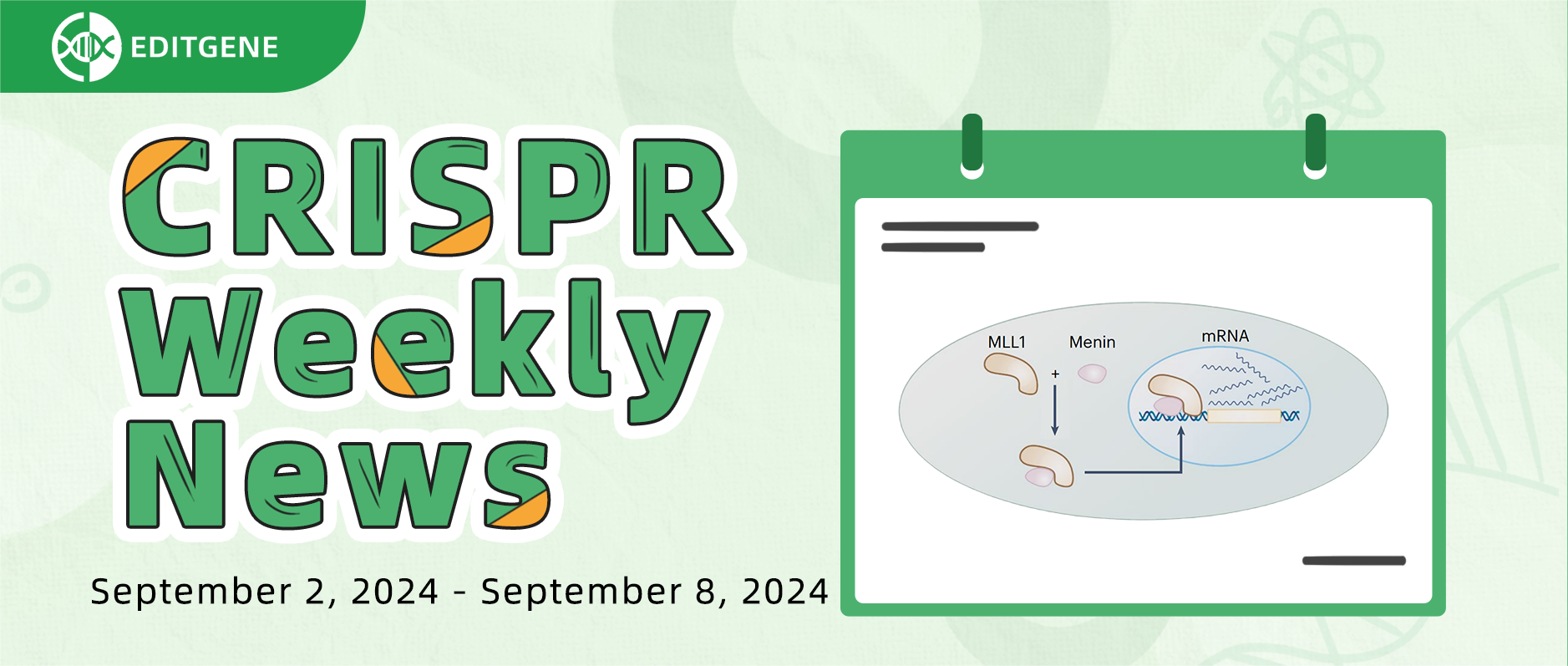[Weekly News] CRISPR-Cas9 Screening Technology Breaks Through the Limitations of Functional Genomic Screening in 2D Cell

CRISPR/Cas technology is a revolutionary tool in modern biological sciences, with applications spanning medicine, agriculture, environmental conservation, and more. New findings and case studies continue to emerge across these fields. Our "CRISPR Weekly News" column brings you the latest research and industry updates. Here's a brief summary of the past week's highlights:
I. Research News
i. CRISPR Screening
1. Title: In vivo CRISPR screens identify a dual function of MEN1 in regulating tumor–microenvironment interactions
Journal: Nature Genetics (Impact Factor: 31.7)
Link: https://doi.org/10.1038/s41588-024-01874-9
Functional genomics screens in 2D cell culture models have limitations in identifying therapeutic targets that affect the tumor microenvironment. To address this, researchers from the University of Toronto, Oxford University, Shanghai Pulmonary Hospital, and Sichuan University compared CRISPR-Cas9 screens in 2D cell cultures and xenograft models. They discovered that MEN1 is a critical gene with tumor microenvironment-dependent effects. MEN1 knockout had no impact on in vitro proliferation but altered tumor growth in mice, promoting growth in immune-deficient models while suppressing it in immune-competent models. Mechanistically, MEN1 loss activates immune pathways by redistributing MLL1 and H3K4me3, enhancing immune cell infiltration and inhibiting menin-MLL interactions, thereby reducing tumor growth. This highlights MEN1 as a potential target for solid tumors.
2. Title: MIG6 loss increased RET inhibitor tolerant persister cells in RET-rearranged non-small cell lung cancer
Journal: Cancer Letters (Impact Factor: 9.1)
Link: https://doi.org/10.1016/j.canlet.2024.217220
RET tyrosine kinase inhibitors (TKIs) are effective for RET-rearranged non-small cell lung cancer (NSCLC) and RET-mutant thyroid cancer, but resistance development limits long-term efficacy. While many mechanisms of RET-TKI resistance are known, some primary or acquired resistance mechanisms remain unclear. A research team from Japan conducted a genome-wide CRISPR/Cas9 screen to identify genes associated with drug-tolerant persister cells. Using patient-derived cells with RET fusions, they introduced a genome-wide sgRNA library and treated cells with RET-TKI for 9 days. The screen identified several candidate genes, with MED12 and MIG6 knockouts significantly increasing the number of persister cells resistant to RET-TKI treatment.
ii. CRISPR Detection
1. Title: Fast and sensitive detection of viable Escherichia coli O157 using a microwell-confined and propidium monoazide-assisted digital CRISPR microfluidic platform
Journal: Lab on a Chip (Impact Factor: 6.1)
Link: https://doi.org/10.1039/D4LC00672K
Escherichia coli O157:H7 is a major foodborne pathogen that poses a significant threat to food safety and public health. Researchers from Zhejiang University developed a CRISPR-based microfluidic platform capable of detecting viable E. coli O157:H7 in food samples with speed and sensitivity, providing results in just 5 minutes. By utilizing propidium monoazide to exclude dead cells and a direct lysis method, the platform achieves a detection limit of 36 CFU/mL in 30 minutes, making it a powerful tool for food safety testing.
2. Title: One-base-mismatch CRISPR-based transistors for single nucleotide resolution assay
Journal: Biosensors and Bioelectronics (Impact Factor: 10.7)
Link: https://doi.org/10.1016/j.bios.2024.116548
Researchers from Fudan University and Shanghai Customs have developed a CRISPR-Cas13a-based transistor biosensor for the rapid and highly selective detection of single nucleotide variations (SNVs) in viral RNA. By leveraging engineered crRNA and graphene channels, this biosensor detects RNA without the need for target amplification, with a detection limit of 5 copies/100 μL. It can distinguish between wild-type RNA and SNV RNA within 15 minutes, offering a sensitive, on-site tool for viral diagnostics, including for influenza and SARS-CoV-2 variants.
iii. Other Detection Technologies
1. Title: Diverse viral cas genes antagonize CRISPR immunity
Journal: Nature (Impact Factor: 50.5)
Link: https://doi.org/10.1038/s41586-024-07923-x
Researchers from the University of Washington have discovered 15 new anti-CRISPR (Acr) gene families in Listeria isolates. These gene families typically inhibit CRISPR-Cas immunity through interactions with Cas proteins. Notably, a homolog of the I-B type Cas protein suppresses the VI type system by degrading crRNA, an unintended effect. Additionally, a broad-spectrum Cas3 homolog has been identified, which can inhibit multiple CRISPR systems.
2. Title: Immunoliposome-based targeted delivery of the CRISPR/Cas9gRNA-IL30 complex inhibits prostate cancer and prolongs survival
Journal: Experimental & Molecular Medicine (Impact Factor: 9.5)
Link: https://doi.org/10.1038/s12276-024-01310-2
Italian scientists have demonstrated the potential of a targeted CRISPR-Cas9 delivery system for inhibiting prostate cancer (PC) growth and metastasis. In this study, a lipid nanoparticle complex conjugated with an anti-prostate stem cell antigen (PSCA) antibody was used to specifically deliver the CRISPR-Cas9 system targeting the immunosuppressive interleukin 30 (IL30) gene to PC cells.
3. Title: Codon usage and expression-based features significantly improve prediction of CRISPR efficiency
Journal: NPJ Systems Biology and Applications (Impact Factor: 3.5)
Link: https://doi.org/10.1038/s41540-024-00431-8
Researchers at Tel Aviv University have introduced new predictive features based on codon usage bias (CUB) and gene expression, significantly enhancing the accuracy of CRISPR efficiency predictions. By integrating these features into existing predictive models, the study improves the ability to forecast CRISPR editing efficacy across different cell types.
II. Industry News
1. Chroma Medicine presented preclinical data of its PCSK9-targeted epigenetic editor at the 2024 European Society of Cardiology Congress. The data showed effective and sustained reductions in PCSK9 and LDL cholesterol levels in non-human primates without DNA cutting, with LDL cholesterol reduced by 68%, lasting up to three months.
2. Caribou Biosciences received FDA Fast Track designation for its CRISPR-edited CAR-T therapies CB-010 and CB-012. CB-010, targeting refractory systemic lupus erythematosus, will enter phase 1 trials by the end of 2024, while CB-012 is being tested for relapsed or refractory acute myeloid leukemia. Both therapies address unmet medical needs, potentially accelerating their approval.
3. YolTech Therapeutics' YOLT-203 received FDA Rare Pediatric Disease designation. YOLT-203 is an in vivo gene-editing therapy for type 1 primary hyperoxaluria (PH1), targeting and correcting AGXT gene mutations using the YolCas12™ CRISPR-Cas system to reduce harmful oxalate accumulation in the kidneys. Recently, the first two patients were dosed in a phase 1 trial.
EDITGENE focuses on CRISPR technology, offering a range of high-quality gene editing services and in vitro diagnostic products.
These include but are not limited to: CRISPR Library Screening, Cell Line Engineering, Monoclonal Cell Line Screening, CRISPR Detection.
We are committed to providing the most efficient technical services for CRISPR-related, gene function research, in vitro diagnostics, and therapeutic research.
Recent Blogs:
Follow us on social media
Contact us
+ 833-226-3234 (USA Toll-free)
+1-224-345-1927 (USA)
info@editxor.com









![[Weekly News] CRISPR-Cas9 Screening Technology Breaks Through the Limitations of Functional Genomic Screening in 2D Cell](/uploads/20241026/5GxopVKXSBd2CyR4_ce9a01bd08f9d18c7d09fad585bc559f.jpg)

Comment (4)